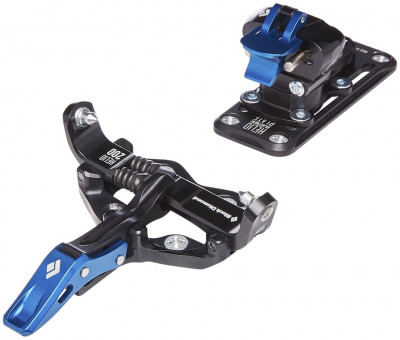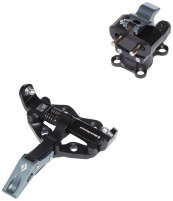Smooth! The Black Diamond Helio 200 is feature-packed, fully capable, and fully awesome. It pairs well with everything from skinny skis and race-boots to big skis and four-buckle boots. If you want your ski binding to do a little bit of everything, then this is the one. Adjustable lateral and vertical release values mean you can dial in the system to your size and style. Two smooth-operating risers offer plenty of climbing prowess. A smooth-adjusting plate under the heel accommodates your boot quiver. The sturdy toe-piece has a roller bearing for incredibly smooth locking operation. The heel pins rotate in a specialized-system that ensures a smooth release. Heel-rotation is also buttery smooth. In sum, the BD Helio 200 could be the smoothest binding on the planet.
- Vertical and lateral release value adjustment from 5-10.
- Monolink 1.0 toe piece is lightweight and easy to step into.
- Cam Release System places heel pins on a sliding axis for a more accurate release.
- Long toe-lever for extra leverage during locking helps clear boot-fittings of debris.
- Mount without the adjustment plates to save around ~34g (1.2oz) of weight.
- Three total riser-heights including flat-on-ski mode.
- Optional crampon receptors (+8g) accept Helio crampons.
- Includes a BD Leash so you don't lose your skis.
| Specifications | |
|
Weight |
210g |
| Weight (pair) | 420g |
|
Boot |
Tech |
|
Brakes |
Leashes |
|
BSL |
28mm |
|
Riser |
2 + flat |
|
Vertical |
5-10 |
|
Lateral |
5-10 |
|
Crampon |
Removable accessory |
| Specs Verified | Yes |
| Design | |
|
|
Aluminum alloy, stainless steel |
| Skimo Co Says | |
| Usage | Ski touring, ski mountaineering |
| Notes | Risers will flip out of the way with a pole |
| Bottom Line | A high-performance binding for most backcountry users |
| Compare to other Lean Bindings | |
Related Products
Questions & Reviews
Thanks,
Daniel
I have a pair of Asnes Rabb 68 (104-68-94) and wonder (in your opinion), if the the Helio 200 bindings could be used on them?
https://www.en.asnes.com/produkt/rabb-68/
If yes, any specific recommendations for the mounting?
If no, do you have any other skis you would recommend for UL setup primarily used for ski traversing? (i.e. not aggressive downhill).
First, thanks for all the great answers!
the Asnes Rabb 68 is intended for use with a Nordic BC binding. I am unsure if the Helio 200 will align with the mounting plate. I would recommend checking with a shop that carries that ski to confirm.
As for alternative ski recommendations, You could go as light as a Skimo Race Ski depending on the terrain and intended use. Reach out to help@skimo.co, and I would be happy to hone in on a ski and binding combo for your backcountry adventures.
I contacted Asnes directly as they do include tech bindings among their own recommendations (see website above), along with the nordic BC which I currently have mounted on them. Not sure if there might be a specific tech binding they had in mind, different from the helio/ATK etc.
Thanks!
I am in my second season with this binding and I am pretty disappointed with the heel riser. It is simply not tall enough.
I have been experimenting with 3d printing an extra piece to attach to it. My design isn't super successful yet. Does skimo have any suggestions for modifications or accessories to make the heel riser taller?
Thanks
Pete
The riser height delta needed is influenced by many factors, including boot sole length, boot walk mode range of motion, friction throughout that range, max angle of local skintracks, willingness to put in an extra kick turn, ankle mobility, etc. Often times, going to a lighter boot can allow you to get better use out of the lower risers on lighter bindings.
If you'd prefer a different binding with taller risers, check out our article on Binding Riser Heights for a full list of measurements!
Just curious, the top of the page says "no longer carry" and not "out of stock" - did you decide to stop carrying them and, if so, why? Or are they just out of stock?
What's the difference between these and the ATK Haute Route 10? They look the same in the photos? The weight is different though?
The reason I'm asking is that the fixture which failed on the Plums looks identical to the fixture on these (and also across the entire BD/ATK line up). Have you seen any issues with these bindings?
I assume you guys are familiar with the issues Plum had. Any idea why Plum run a quite different looking fixture to BD/ATK? The Plum fixture has a flat face and is slightly 'bigger' while the BD/ATK fixture has a significant dimple into the pin.
Cheers,
Tom.
I bought these bindings about a year ago and they've been my binding on my primary touring ski since, I've put about 50 days on them. I've skied several volcanoes on them: Mt Hood, Mt Adams, Mt Saint Helens, Mt Bachelor. I've skied every possible kind of PNW snow imaginable on them from schmoo to chunder to ice to powder to hot pow to corn to corn chowder.
When I first got these bindings I had their adjustable release set too low and I was having pre-releases in our wet heavy pacific northwest snow pack. But after adjusting them up a couple notches I'm good to go!
I will confess I do not use the multiple riser positions, instead I treat the heel piece more like a race heel piece and leave it rotated with the pins forward and then I just flip the middle riser to switch between walk and ski mode. This middle riser position is fine for me for any terrain, and this makes transitions fast and easy.
I'm 5'4" 150lbs and I ski these bindings mounted to the Movement AlpTrack 94 169cm, with Atomic Backland Ultimate Boots.
Toe: 30mm
Heel: 36.5mm (including adjustment plate), 31mm without the adjustment plate.
With the adjustment plate the binding delta is 6.5mm. Without the adjustment plate, the binding is nearly flat.
Earn store credit by writing reviews. Learn more.













